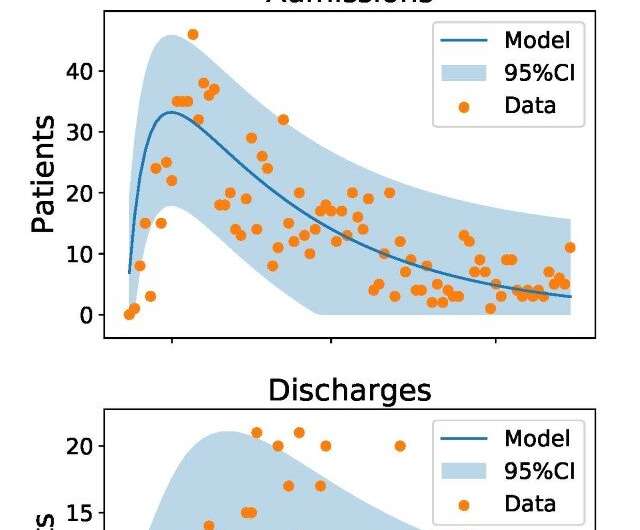

A Sussex team—including university mathematicians—have created a new modeling toolkit which predicts the impact of COVID-19 at a local level with unprecedented accuracy. The details are published in the International Journal of Epidemiology, and are available for other local authorities to use online, just as the UK looks as though it may head into another wave of infections.
The study used the local Sussex hospital and healthcare daily COVID-19 situation reports, including admissions, discharges, bed occupancy and deaths.
Through the pandemic, the newly-published modeling has been used by local NHS and public health services to predict infection levels so that public services can plan when and how to allocate health resources—and it has been conclusively shown to be accurate. The team are now making their modeling available to other local authorities to use via the Halogen toolkit.
Anotida Madzvamuse, professor of mathematical and computational biology within the School of Mathematical and Physical Sciences at the University of Sussex, who led of the study, says that they “undertook this study as a rapid response to the COVID-19 pandemic. Our objective was to provide support and enhance the capability of local NHS and Public Health teams to accurately predict and forecast the impact of local outbreaks to guide healthcare demand and capacity, policy making, and public health decisions.”
“Working with outstanding mathematicians, Dr. James Van Yperen and Dr. Eduard Campillo-Funollet, we formulated an epidemiological model and inferred model parameters by fitting the model to local datasets to allow for short, and medium-term predictions and forecasts of the impact of COVID-19 outbreaks.”
“I’m really pleased that our modeling has been of such value to local health services and people. The modeling approach can be used by local authorities to predict the dynamics of other conditions such as winter flu and mental health problems.”
Professor Anjum Memon, Chair in Epidemiology and Public Health Medicine at BSMS and co-author of the study, said that “the world is in the cusp of experiencing local and regional hotspots and spikes of COVID-19 infections. Our epidemiological model, which is based on local data, can be used by all local authorities in the UK and other countries to inform healthcare demand and capacity, emergency planning and response to the supply of medications and oxygen, formulation, tightening or lifting of legal restrictions and implementation of preventive measures.”
“The model will also serve as an excellent tool to monitor the situation after the legal COVID-19 restrictions are lifted in England on 19 July, and during winter months with competing respiratory infections.”
Kate Gilchrist, Head of Public Health Intelligence at Brighton & Hove City Council and co-author of the study, says that “this unique piece of work demonstrated that by using local datasets, model predictions and forecasting allowed us to plan adequately the healthcare demand and capacity, as well as policy-making and public health decisions to mitigate the impact of COVID-19 on the local population. Understanding how future COVID-19 spikes and waves could possibly affect the local populations empowers us to ensure that contingency measures are in place and the timely commissioning and organization of services.”
Source: Read Full Article